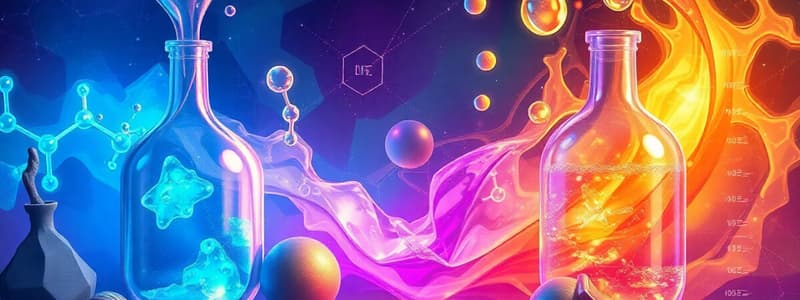Podcast
Questions and Answers
How does the arrangement of particles differ between solids, liquids, and gases?
How does the arrangement of particles differ between solids, liquids, and gases?
In solids, particles are tightly packed in a fixed arrangement. In liquids, particles are closely packed but can move around. In gases, particles are widely dispersed and move randomly.
Explain the relationship between an element's position on the periodic table (group and period) and its properties.
Explain the relationship between an element's position on the periodic table (group and period) and its properties.
Elements in the same group have similar chemical properties due to the same number of valence electrons. Elements in the same period have the same number of electron shells. Properties vary across a period.
How does the density equation relate mass and volume to calculate density?
How does the density equation relate mass and volume to calculate density?
Density is calculated by dividing mass by volume ($Density = \frac{Mass}{Volume}$).
Describe 3 physical properties that can be used to identify a substance.
Describe 3 physical properties that can be used to identify a substance.
Explain the difference between a physical change and a chemical change, providing an example of each.
Explain the difference between a physical change and a chemical change, providing an example of each.
What are the charges of an ion, an anion, and a cation?
What are the charges of an ion, an anion, and a cation?
State the four principles of the Particle Theory of Matter.
State the four principles of the Particle Theory of Matter.
Explain how to determine the number of neutrons in an atom, given its mass number and atomic number.
Explain how to determine the number of neutrons in an atom, given its mass number and atomic number.
Describe how metals and nonmetals differ in terms of their malleability and conductivity.
Describe how metals and nonmetals differ in terms of their malleability and conductivity.
How is the Bohr-Rutherford diagram useful for visualizing the structure of an atom?
How is the Bohr-Rutherford diagram useful for visualizing the structure of an atom?
What information can be gained from reading a chemical formula like $H_2O$?
What information can be gained from reading a chemical formula like $H_2O$?
Why is knowing if a substance is combustible or reacts with acid important?
Why is knowing if a substance is combustible or reacts with acid important?
Explain how an atom that gains electrons is different from an atom that loses electrons.
Explain how an atom that gains electrons is different from an atom that loses electrons.
Describe the difference between an atom in the ground state and an atom in the excited state.
Describe the difference between an atom in the ground state and an atom in the excited state.
What does it mean when it is stated that 'there is nothing between particles'?
What does it mean when it is stated that 'there is nothing between particles'?
How would you test for the presence of hydrogen gas in a laboratory setting?
How would you test for the presence of hydrogen gas in a laboratory setting?
What is the significance of alkali metals, noble gases, and halogens being located in specific groups on the periodic table?
What is the significance of alkali metals, noble gases, and halogens being located in specific groups on the periodic table?
List 3 of the 8 physical changes.
List 3 of the 8 physical changes.
List the 3 examples of chemical changes.
List the 3 examples of chemical changes.
Flashcards
Physical Property
Physical Property
A property that can be observed or measured without changing the substance's chemical identity.
Qualitative Property
Qualitative Property
A property that can be observed or measured with the senses; descriptive but not numerical.
Quantitative Property
Quantitative Property
A property that can be measured and expressed with a numerical value.
Chemical Property
Chemical Property
Signup and view all the flashcards
Combustibility
Combustibility
Signup and view all the flashcards
Density
Density
Signup and view all the flashcards
Matter
Matter
Signup and view all the flashcards
Physical Change
Physical Change
Signup and view all the flashcards
Chemical Change
Chemical Change
Signup and view all the flashcards
Particle Theory of Matter
Particle Theory of Matter
Signup and view all the flashcards
Atomic Number
Atomic Number
Signup and view all the flashcards
Mass Number
Mass Number
Signup and view all the flashcards
Period
Period
Signup and view all the flashcards
Group
Group
Signup and view all the flashcards
Ground State
Ground State
Signup and view all the flashcards
Excited State
Excited State
Signup and view all the flashcards
Ion
Ion
Signup and view all the flashcards
Anion
Anion
Signup and view all the flashcards
Cation
Cation
Signup and view all the flashcards
Study Notes
- The Chemistry SNC 1W test is on Monday, March 31, 2025
- The test includes multiple choice (15 marks), matching (10 marks), true or false (10 marks), and short answer (15 marks), for a total of 50 marks
- A periodic table is provided for the test.
Key Definitions
- Physical property, qualitative property, quantitative property, chemical property
- Physical change and chemical change
- Matter
- Atomic number, mass number
- Period, group
- Excited state, ground state
- Ion, anion, cation
Key Concepts
- Color, odor, taste, texture, and solubility are physical properties
- Combustibility and reaction with acid are chemical properties
- The density equation
- Salt, sugar, and baking soda are soluble; baking soda reacts with acid
- The 4 principles of "The Particle Theory of Matter"
- There is nothing between particles
- How particles are arranged in solids, liquids, and gases
- Metals are ductile, malleable, shiny, and conductors; nonmetals are nonductile, nonmalleable, dull, and insulators
- All matter is made of atoms
- Parts of the Atom from "The Structure of the Atom"
- How to calculate the number of neutrons using the formula: # of neutrons = mass number – atomic number
- How to draw Bohr diagrams and Bohr-Rutherford diagrams
- How to read a chemical formula; H2O contains two hydrogen atoms and one oxygen atom
- Location of the Noble Gases, Alkali Metals, and Halogens on the Periodic Table
- An atom that gains electrons is negatively charged, and an atom that loses electrons is positively charged
- How to determine the chemical formula and chemical name given two elements that combine
- Tests for Hydrogen, Oxygen, and Carbon Dioxide
- List the 8 physical changes
- List the 3 examples of chemical changes
Studying That Suits You
Use AI to generate personalized quizzes and flashcards to suit your learning preferences.




